Analyzing Human Happiness: The Roles of CPM and HRM in Achieving it
VerifiedAdded on 2021/09/14
|9
|2172
|44
Essay
AI Summary
This essay explores the relationship between Human Resource Management (HRM) and Contemporary People Management (CPM), examining how these disciplines contribute to human happiness through the lens of Utilitarianism and the Happiness Principle. It discusses the evolution of HRM, its strategic importance, and its connection to ethical considerations. The essay highlights how CPM, as a subset of HRM, emphasizes the importance of employees and their well-being. It analyzes Utilitarianism, focusing on its aim to maximize overall happiness and welfare, while also acknowledging its criticisms regarding ethical considerations. The essay concludes that HRM and CPM play a crucial role in achieving organizational goals and promoting a positive work environment, thereby contributing to the overall happiness of employees.
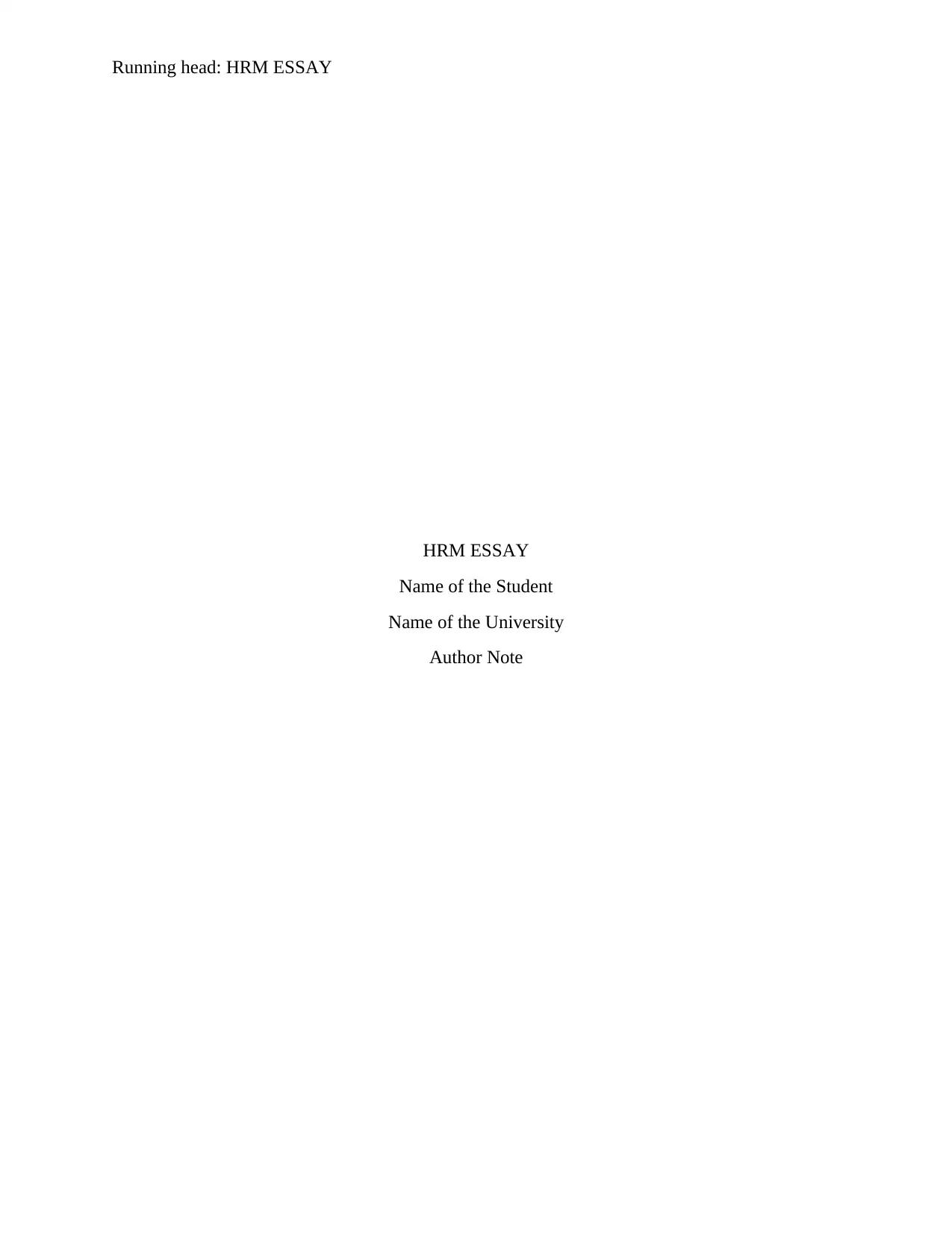
Running head: HRM ESSAY
HRM ESSAY
Name of the Student
Name of the University
Author Note
HRM ESSAY
Name of the Student
Name of the University
Author Note
Paraphrase This Document
Need a fresh take? Get an instant paraphrase of this document with our AI Paraphraser
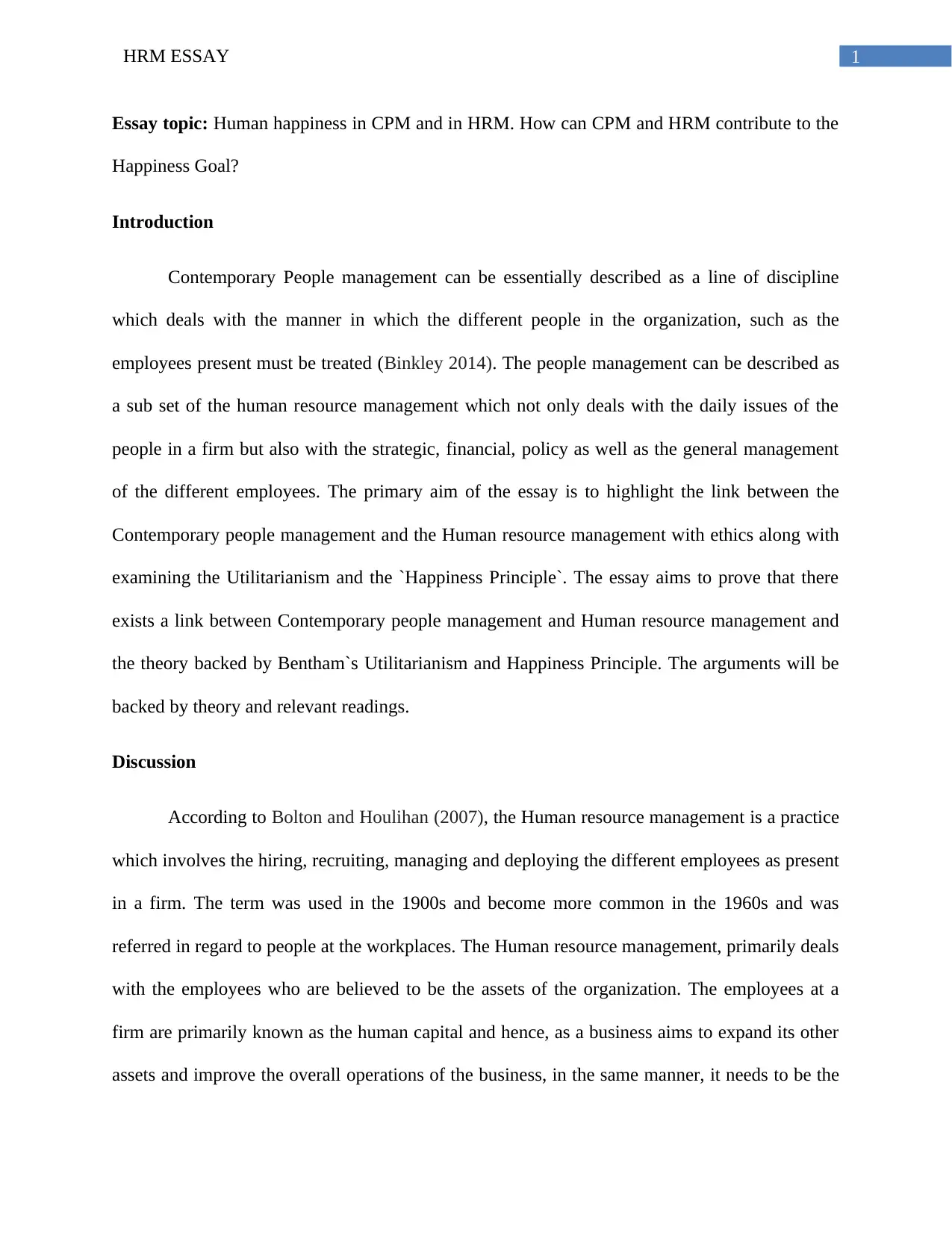
1HRM ESSAY
Essay topic: Human happiness in CPM and in HRM. How can CPM and HRM contribute to the
Happiness Goal?
Introduction
Contemporary People management can be essentially described as a line of discipline
which deals with the manner in which the different people in the organization, such as the
employees present must be treated (Binkley 2014). The people management can be described as
a sub set of the human resource management which not only deals with the daily issues of the
people in a firm but also with the strategic, financial, policy as well as the general management
of the different employees. The primary aim of the essay is to highlight the link between the
Contemporary people management and the Human resource management with ethics along with
examining the Utilitarianism and the `Happiness Principle`. The essay aims to prove that there
exists a link between Contemporary people management and Human resource management and
the theory backed by Bentham`s Utilitarianism and Happiness Principle. The arguments will be
backed by theory and relevant readings.
Discussion
According to Bolton and Houlihan (2007), the Human resource management is a practice
which involves the hiring, recruiting, managing and deploying the different employees as present
in a firm. The term was used in the 1900s and become more common in the 1960s and was
referred in regard to people at the workplaces. The Human resource management, primarily deals
with the employees who are believed to be the assets of the organization. The employees at a
firm are primarily known as the human capital and hence, as a business aims to expand its other
assets and improve the overall operations of the business, in the same manner, it needs to be the
Essay topic: Human happiness in CPM and in HRM. How can CPM and HRM contribute to the
Happiness Goal?
Introduction
Contemporary People management can be essentially described as a line of discipline
which deals with the manner in which the different people in the organization, such as the
employees present must be treated (Binkley 2014). The people management can be described as
a sub set of the human resource management which not only deals with the daily issues of the
people in a firm but also with the strategic, financial, policy as well as the general management
of the different employees. The primary aim of the essay is to highlight the link between the
Contemporary people management and the Human resource management with ethics along with
examining the Utilitarianism and the `Happiness Principle`. The essay aims to prove that there
exists a link between Contemporary people management and Human resource management and
the theory backed by Bentham`s Utilitarianism and Happiness Principle. The arguments will be
backed by theory and relevant readings.
Discussion
According to Bolton and Houlihan (2007), the Human resource management is a practice
which involves the hiring, recruiting, managing and deploying the different employees as present
in a firm. The term was used in the 1900s and become more common in the 1960s and was
referred in regard to people at the workplaces. The Human resource management, primarily deals
with the employees who are believed to be the assets of the organization. The employees at a
firm are primarily known as the human capital and hence, as a business aims to expand its other
assets and improve the overall operations of the business, in the same manner, it needs to be the
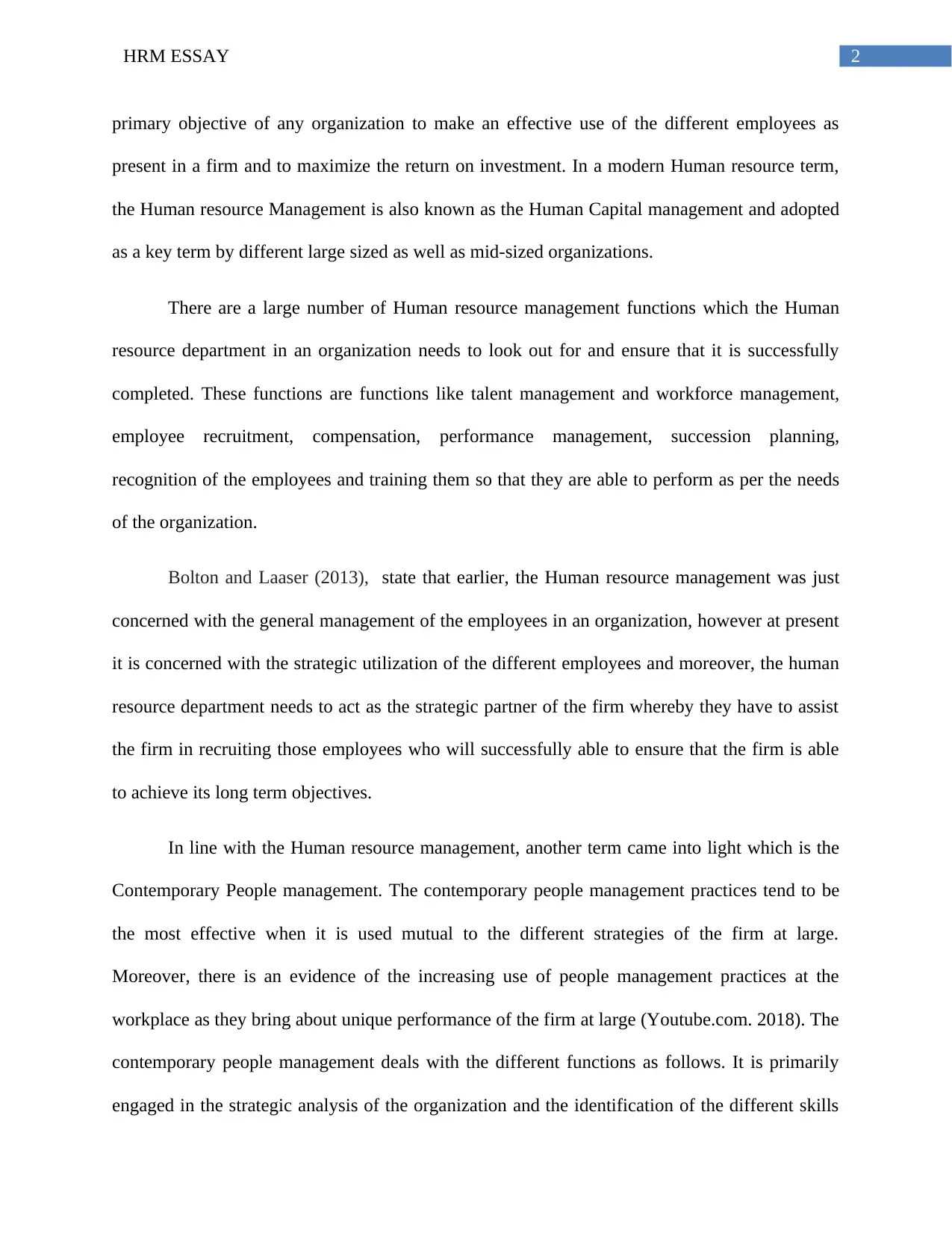
2HRM ESSAY
primary objective of any organization to make an effective use of the different employees as
present in a firm and to maximize the return on investment. In a modern Human resource term,
the Human resource Management is also known as the Human Capital management and adopted
as a key term by different large sized as well as mid-sized organizations.
There are a large number of Human resource management functions which the Human
resource department in an organization needs to look out for and ensure that it is successfully
completed. These functions are functions like talent management and workforce management,
employee recruitment, compensation, performance management, succession planning,
recognition of the employees and training them so that they are able to perform as per the needs
of the organization.
Bolton and Laaser (2013), state that earlier, the Human resource management was just
concerned with the general management of the employees in an organization, however at present
it is concerned with the strategic utilization of the different employees and moreover, the human
resource department needs to act as the strategic partner of the firm whereby they have to assist
the firm in recruiting those employees who will successfully able to ensure that the firm is able
to achieve its long term objectives.
In line with the Human resource management, another term came into light which is the
Contemporary People management. The contemporary people management practices tend to be
the most effective when it is used mutual to the different strategies of the firm at large.
Moreover, there is an evidence of the increasing use of people management practices at the
workplace as they bring about unique performance of the firm at large (Youtube.com. 2018). The
contemporary people management deals with the different functions as follows. It is primarily
engaged in the strategic analysis of the organization and the identification of the different skills
primary objective of any organization to make an effective use of the different employees as
present in a firm and to maximize the return on investment. In a modern Human resource term,
the Human resource Management is also known as the Human Capital management and adopted
as a key term by different large sized as well as mid-sized organizations.
There are a large number of Human resource management functions which the Human
resource department in an organization needs to look out for and ensure that it is successfully
completed. These functions are functions like talent management and workforce management,
employee recruitment, compensation, performance management, succession planning,
recognition of the employees and training them so that they are able to perform as per the needs
of the organization.
Bolton and Laaser (2013), state that earlier, the Human resource management was just
concerned with the general management of the employees in an organization, however at present
it is concerned with the strategic utilization of the different employees and moreover, the human
resource department needs to act as the strategic partner of the firm whereby they have to assist
the firm in recruiting those employees who will successfully able to ensure that the firm is able
to achieve its long term objectives.
In line with the Human resource management, another term came into light which is the
Contemporary People management. The contemporary people management practices tend to be
the most effective when it is used mutual to the different strategies of the firm at large.
Moreover, there is an evidence of the increasing use of people management practices at the
workplace as they bring about unique performance of the firm at large (Youtube.com. 2018). The
contemporary people management deals with the different functions as follows. It is primarily
engaged in the strategic analysis of the organization and the identification of the different skills
⊘ This is a preview!⊘
Do you want full access?
Subscribe today to unlock all pages.

Trusted by 1+ million students worldwide
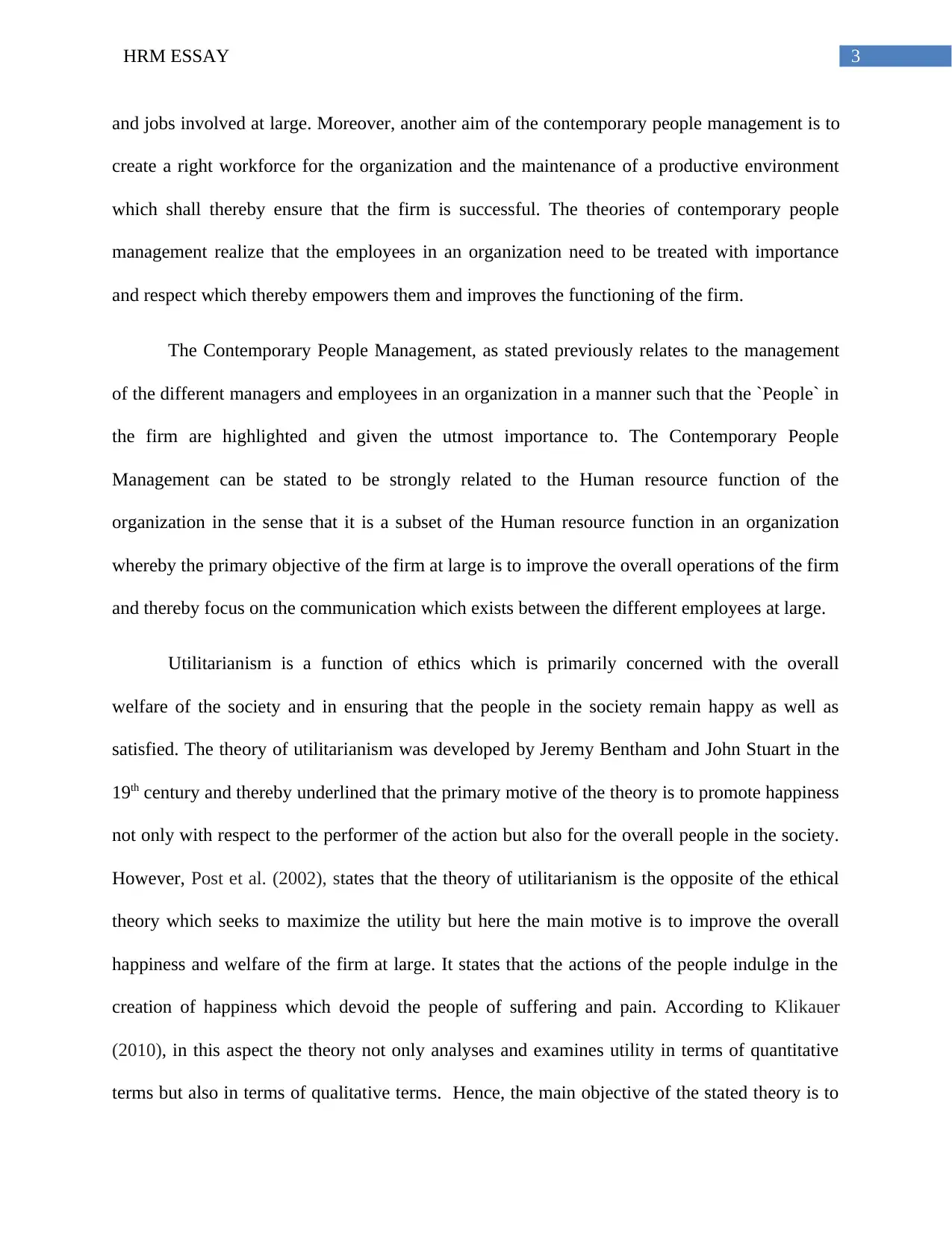
3HRM ESSAY
and jobs involved at large. Moreover, another aim of the contemporary people management is to
create a right workforce for the organization and the maintenance of a productive environment
which shall thereby ensure that the firm is successful. The theories of contemporary people
management realize that the employees in an organization need to be treated with importance
and respect which thereby empowers them and improves the functioning of the firm.
The Contemporary People Management, as stated previously relates to the management
of the different managers and employees in an organization in a manner such that the `People` in
the firm are highlighted and given the utmost importance to. The Contemporary People
Management can be stated to be strongly related to the Human resource function of the
organization in the sense that it is a subset of the Human resource function in an organization
whereby the primary objective of the firm at large is to improve the overall operations of the firm
and thereby focus on the communication which exists between the different employees at large.
Utilitarianism is a function of ethics which is primarily concerned with the overall
welfare of the society and in ensuring that the people in the society remain happy as well as
satisfied. The theory of utilitarianism was developed by Jeremy Bentham and John Stuart in the
19th century and thereby underlined that the primary motive of the theory is to promote happiness
not only with respect to the performer of the action but also for the overall people in the society.
However, Post et al. (2002), states that the theory of utilitarianism is the opposite of the ethical
theory which seeks to maximize the utility but here the main motive is to improve the overall
happiness and welfare of the firm at large. It states that the actions of the people indulge in the
creation of happiness which devoid the people of suffering and pain. According to Klikauer
(2010), in this aspect the theory not only analyses and examines utility in terms of quantitative
terms but also in terms of qualitative terms. Hence, the main objective of the stated theory is to
and jobs involved at large. Moreover, another aim of the contemporary people management is to
create a right workforce for the organization and the maintenance of a productive environment
which shall thereby ensure that the firm is successful. The theories of contemporary people
management realize that the employees in an organization need to be treated with importance
and respect which thereby empowers them and improves the functioning of the firm.
The Contemporary People Management, as stated previously relates to the management
of the different managers and employees in an organization in a manner such that the `People` in
the firm are highlighted and given the utmost importance to. The Contemporary People
Management can be stated to be strongly related to the Human resource function of the
organization in the sense that it is a subset of the Human resource function in an organization
whereby the primary objective of the firm at large is to improve the overall operations of the firm
and thereby focus on the communication which exists between the different employees at large.
Utilitarianism is a function of ethics which is primarily concerned with the overall
welfare of the society and in ensuring that the people in the society remain happy as well as
satisfied. The theory of utilitarianism was developed by Jeremy Bentham and John Stuart in the
19th century and thereby underlined that the primary motive of the theory is to promote happiness
not only with respect to the performer of the action but also for the overall people in the society.
However, Post et al. (2002), states that the theory of utilitarianism is the opposite of the ethical
theory which seeks to maximize the utility but here the main motive is to improve the overall
happiness and welfare of the firm at large. It states that the actions of the people indulge in the
creation of happiness which devoid the people of suffering and pain. According to Klikauer
(2010), in this aspect the theory not only analyses and examines utility in terms of quantitative
terms but also in terms of qualitative terms. Hence, the main objective of the stated theory is to
Paraphrase This Document
Need a fresh take? Get an instant paraphrase of this document with our AI Paraphraser
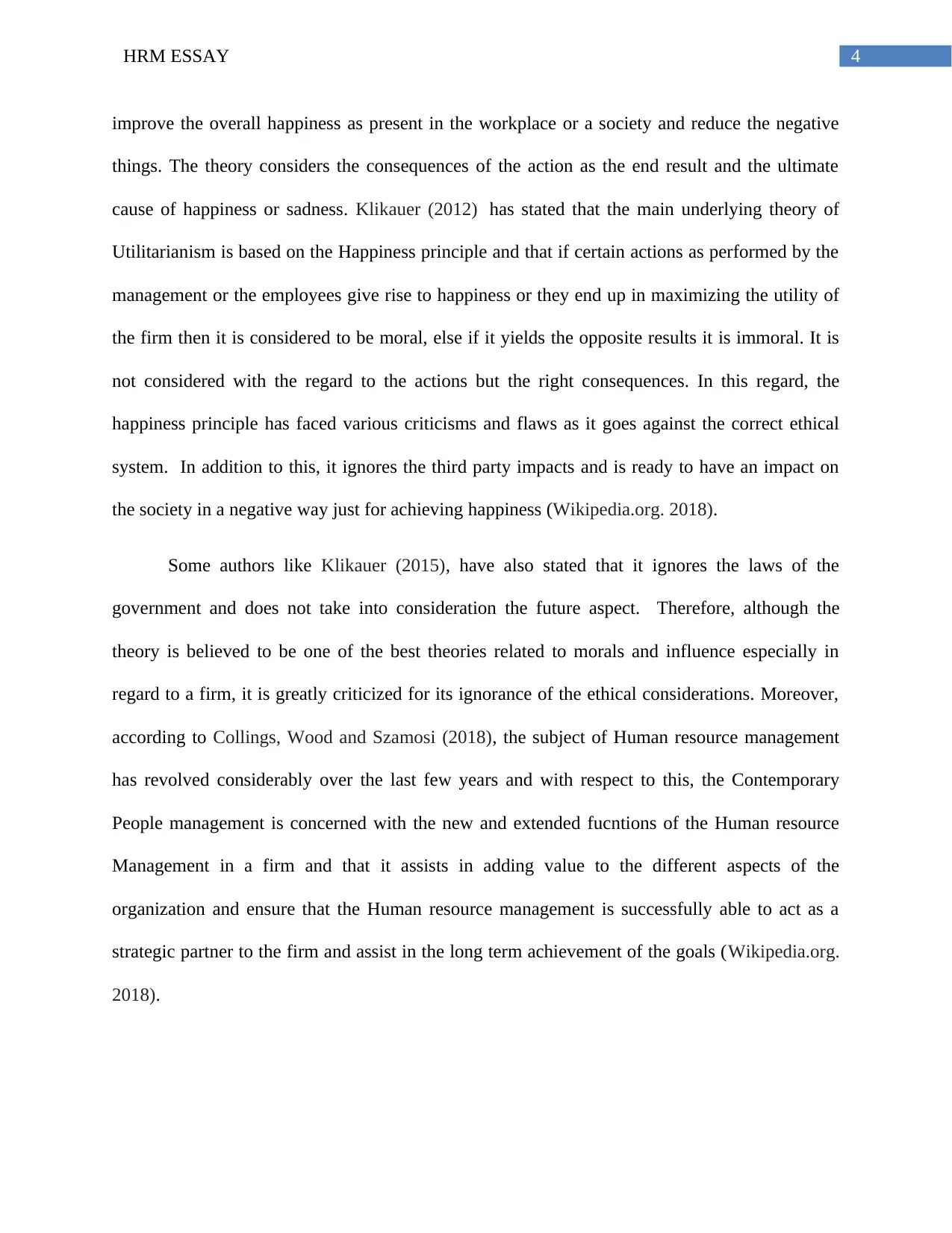
4HRM ESSAY
improve the overall happiness as present in the workplace or a society and reduce the negative
things. The theory considers the consequences of the action as the end result and the ultimate
cause of happiness or sadness. Klikauer (2012) has stated that the main underlying theory of
Utilitarianism is based on the Happiness principle and that if certain actions as performed by the
management or the employees give rise to happiness or they end up in maximizing the utility of
the firm then it is considered to be moral, else if it yields the opposite results it is immoral. It is
not considered with the regard to the actions but the right consequences. In this regard, the
happiness principle has faced various criticisms and flaws as it goes against the correct ethical
system. In addition to this, it ignores the third party impacts and is ready to have an impact on
the society in a negative way just for achieving happiness (Wikipedia.org. 2018).
Some authors like Klikauer (2015), have also stated that it ignores the laws of the
government and does not take into consideration the future aspect. Therefore, although the
theory is believed to be one of the best theories related to morals and influence especially in
regard to a firm, it is greatly criticized for its ignorance of the ethical considerations. Moreover,
according to Collings, Wood and Szamosi (2018), the subject of Human resource management
has revolved considerably over the last few years and with respect to this, the Contemporary
People management is concerned with the new and extended fucntions of the Human resource
Management in a firm and that it assists in adding value to the different aspects of the
organization and ensure that the Human resource management is successfully able to act as a
strategic partner to the firm and assist in the long term achievement of the goals (Wikipedia.org.
2018).
improve the overall happiness as present in the workplace or a society and reduce the negative
things. The theory considers the consequences of the action as the end result and the ultimate
cause of happiness or sadness. Klikauer (2012) has stated that the main underlying theory of
Utilitarianism is based on the Happiness principle and that if certain actions as performed by the
management or the employees give rise to happiness or they end up in maximizing the utility of
the firm then it is considered to be moral, else if it yields the opposite results it is immoral. It is
not considered with the regard to the actions but the right consequences. In this regard, the
happiness principle has faced various criticisms and flaws as it goes against the correct ethical
system. In addition to this, it ignores the third party impacts and is ready to have an impact on
the society in a negative way just for achieving happiness (Wikipedia.org. 2018).
Some authors like Klikauer (2015), have also stated that it ignores the laws of the
government and does not take into consideration the future aspect. Therefore, although the
theory is believed to be one of the best theories related to morals and influence especially in
regard to a firm, it is greatly criticized for its ignorance of the ethical considerations. Moreover,
according to Collings, Wood and Szamosi (2018), the subject of Human resource management
has revolved considerably over the last few years and with respect to this, the Contemporary
People management is concerned with the new and extended fucntions of the Human resource
Management in a firm and that it assists in adding value to the different aspects of the
organization and ensure that the Human resource management is successfully able to act as a
strategic partner to the firm and assist in the long term achievement of the goals (Wikipedia.org.
2018).
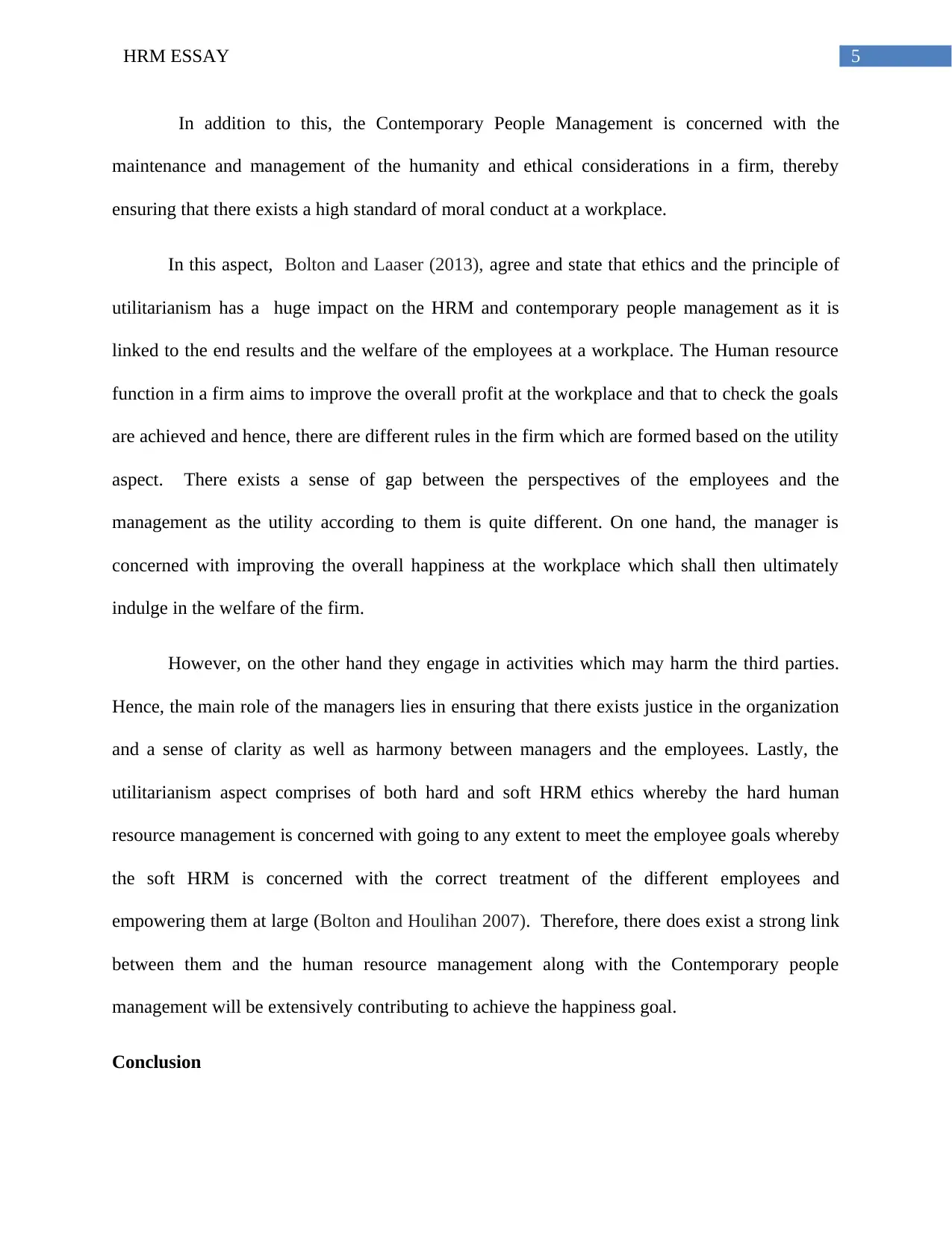
5HRM ESSAY
In addition to this, the Contemporary People Management is concerned with the
maintenance and management of the humanity and ethical considerations in a firm, thereby
ensuring that there exists a high standard of moral conduct at a workplace.
In this aspect, Bolton and Laaser (2013), agree and state that ethics and the principle of
utilitarianism has a huge impact on the HRM and contemporary people management as it is
linked to the end results and the welfare of the employees at a workplace. The Human resource
function in a firm aims to improve the overall profit at the workplace and that to check the goals
are achieved and hence, there are different rules in the firm which are formed based on the utility
aspect. There exists a sense of gap between the perspectives of the employees and the
management as the utility according to them is quite different. On one hand, the manager is
concerned with improving the overall happiness at the workplace which shall then ultimately
indulge in the welfare of the firm.
However, on the other hand they engage in activities which may harm the third parties.
Hence, the main role of the managers lies in ensuring that there exists justice in the organization
and a sense of clarity as well as harmony between managers and the employees. Lastly, the
utilitarianism aspect comprises of both hard and soft HRM ethics whereby the hard human
resource management is concerned with going to any extent to meet the employee goals whereby
the soft HRM is concerned with the correct treatment of the different employees and
empowering them at large (Bolton and Houlihan 2007). Therefore, there does exist a strong link
between them and the human resource management along with the Contemporary people
management will be extensively contributing to achieve the happiness goal.
Conclusion
In addition to this, the Contemporary People Management is concerned with the
maintenance and management of the humanity and ethical considerations in a firm, thereby
ensuring that there exists a high standard of moral conduct at a workplace.
In this aspect, Bolton and Laaser (2013), agree and state that ethics and the principle of
utilitarianism has a huge impact on the HRM and contemporary people management as it is
linked to the end results and the welfare of the employees at a workplace. The Human resource
function in a firm aims to improve the overall profit at the workplace and that to check the goals
are achieved and hence, there are different rules in the firm which are formed based on the utility
aspect. There exists a sense of gap between the perspectives of the employees and the
management as the utility according to them is quite different. On one hand, the manager is
concerned with improving the overall happiness at the workplace which shall then ultimately
indulge in the welfare of the firm.
However, on the other hand they engage in activities which may harm the third parties.
Hence, the main role of the managers lies in ensuring that there exists justice in the organization
and a sense of clarity as well as harmony between managers and the employees. Lastly, the
utilitarianism aspect comprises of both hard and soft HRM ethics whereby the hard human
resource management is concerned with going to any extent to meet the employee goals whereby
the soft HRM is concerned with the correct treatment of the different employees and
empowering them at large (Bolton and Houlihan 2007). Therefore, there does exist a strong link
between them and the human resource management along with the Contemporary people
management will be extensively contributing to achieve the happiness goal.
Conclusion
⊘ This is a preview!⊘
Do you want full access?
Subscribe today to unlock all pages.

Trusted by 1+ million students worldwide
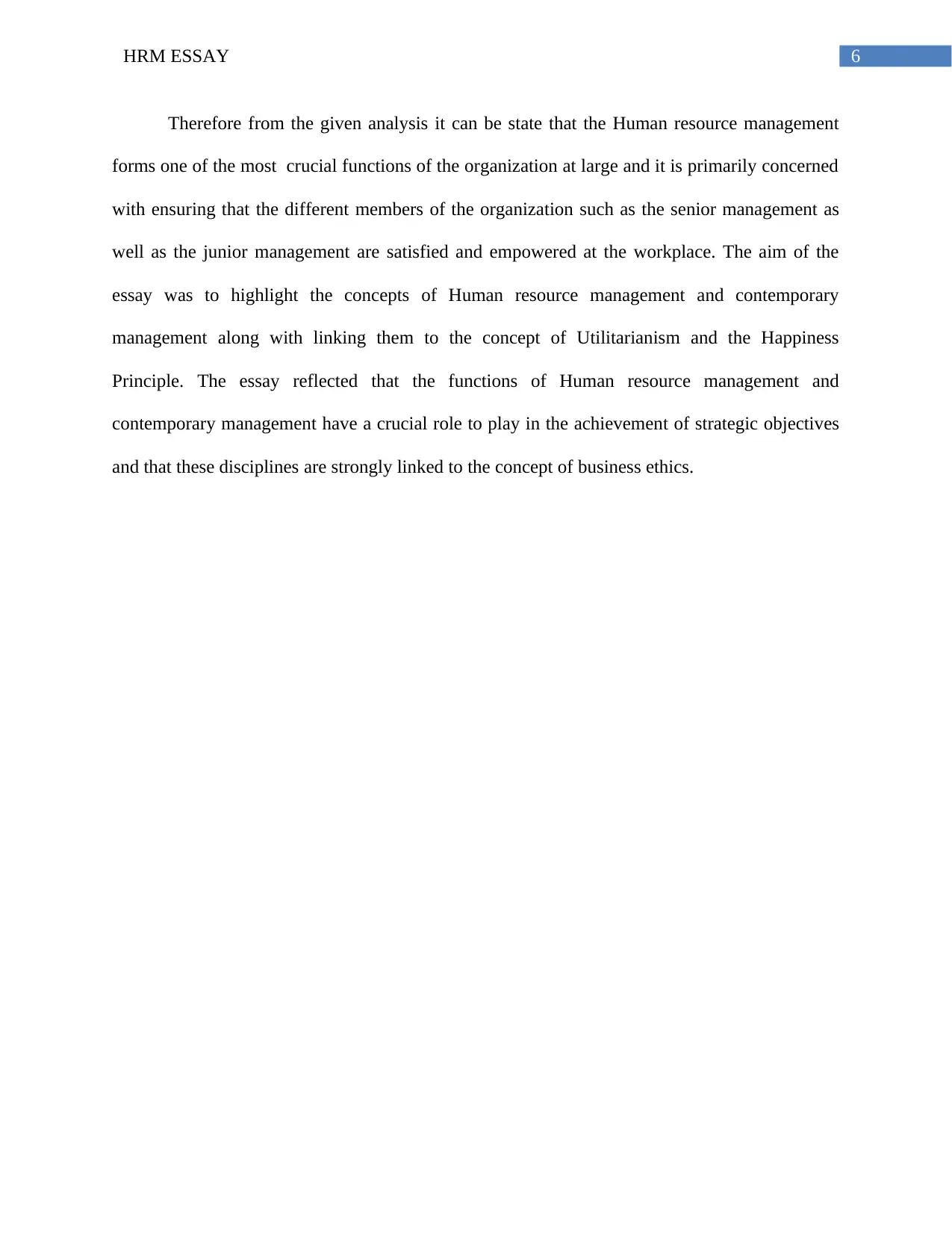
6HRM ESSAY
Therefore from the given analysis it can be state that the Human resource management
forms one of the most crucial functions of the organization at large and it is primarily concerned
with ensuring that the different members of the organization such as the senior management as
well as the junior management are satisfied and empowered at the workplace. The aim of the
essay was to highlight the concepts of Human resource management and contemporary
management along with linking them to the concept of Utilitarianism and the Happiness
Principle. The essay reflected that the functions of Human resource management and
contemporary management have a crucial role to play in the achievement of strategic objectives
and that these disciplines are strongly linked to the concept of business ethics.
Therefore from the given analysis it can be state that the Human resource management
forms one of the most crucial functions of the organization at large and it is primarily concerned
with ensuring that the different members of the organization such as the senior management as
well as the junior management are satisfied and empowered at the workplace. The aim of the
essay was to highlight the concepts of Human resource management and contemporary
management along with linking them to the concept of Utilitarianism and the Happiness
Principle. The essay reflected that the functions of Human resource management and
contemporary management have a crucial role to play in the achievement of strategic objectives
and that these disciplines are strongly linked to the concept of business ethics.
Paraphrase This Document
Need a fresh take? Get an instant paraphrase of this document with our AI Paraphraser
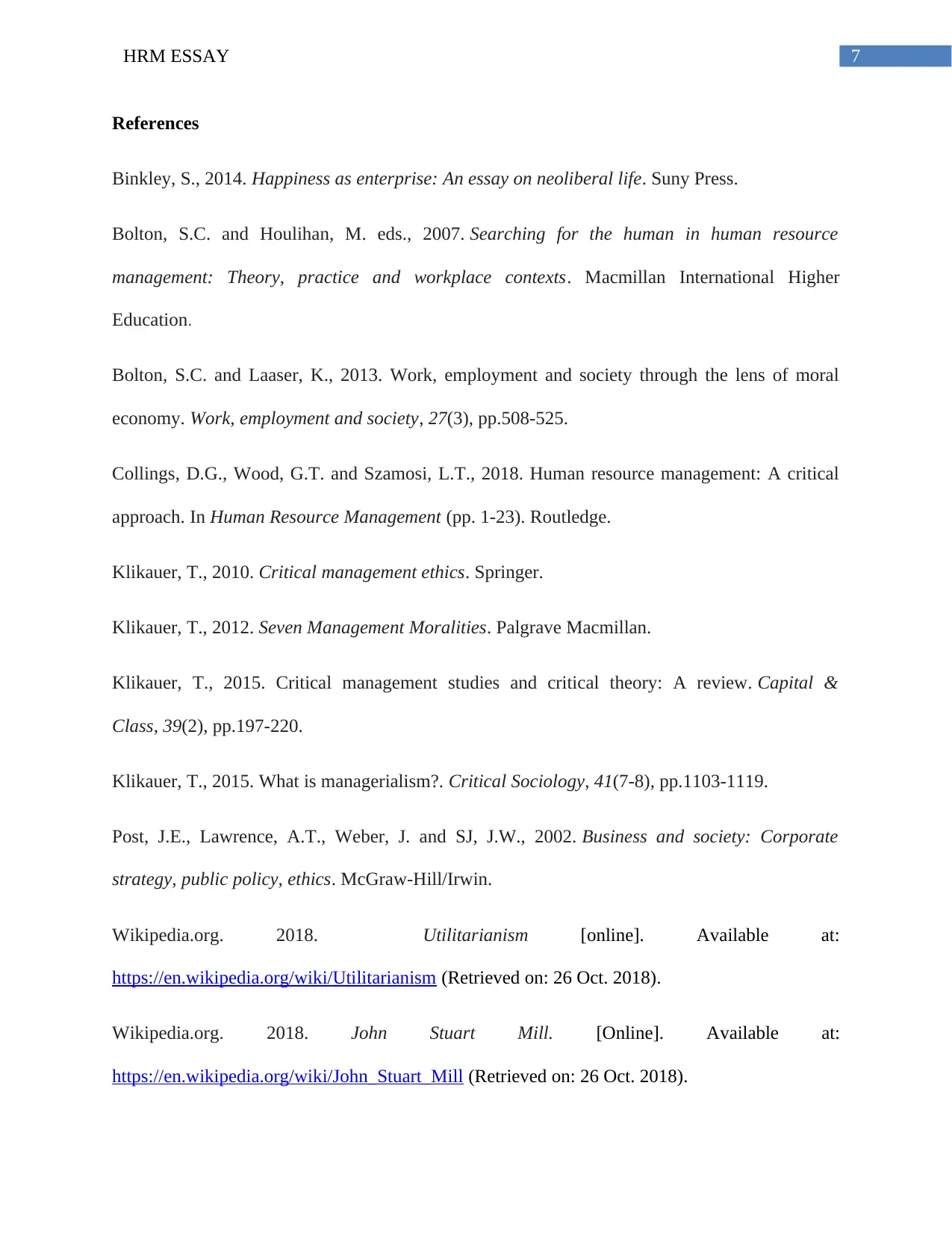
7HRM ESSAY
References
Binkley, S., 2014. Happiness as enterprise: An essay on neoliberal life. Suny Press.
Bolton, S.C. and Houlihan, M. eds., 2007. Searching for the human in human resource
management: Theory, practice and workplace contexts. Macmillan International Higher
Education.
Bolton, S.C. and Laaser, K., 2013. Work, employment and society through the lens of moral
economy. Work, employment and society, 27(3), pp.508-525.
Collings, D.G., Wood, G.T. and Szamosi, L.T., 2018. Human resource management: A critical
approach. In Human Resource Management (pp. 1-23). Routledge.
Klikauer, T., 2010. Critical management ethics. Springer.
Klikauer, T., 2012. Seven Management Moralities. Palgrave Macmillan.
Klikauer, T., 2015. Critical management studies and critical theory: A review. Capital &
Class, 39(2), pp.197-220.
Klikauer, T., 2015. What is managerialism?. Critical Sociology, 41(7-8), pp.1103-1119.
Post, J.E., Lawrence, A.T., Weber, J. and SJ, J.W., 2002. Business and society: Corporate
strategy, public policy, ethics. McGraw-Hill/Irwin.
Wikipedia.org. 2018. Utilitarianism [online]. Available at:
https://en.wikipedia.org/wiki/Utilitarianism (Retrieved on: 26 Oct. 2018).
Wikipedia.org. 2018. John Stuart Mill. [Online]. Available at:
https://en.wikipedia.org/wiki/John_Stuart_Mill (Retrieved on: 26 Oct. 2018).
References
Binkley, S., 2014. Happiness as enterprise: An essay on neoliberal life. Suny Press.
Bolton, S.C. and Houlihan, M. eds., 2007. Searching for the human in human resource
management: Theory, practice and workplace contexts. Macmillan International Higher
Education.
Bolton, S.C. and Laaser, K., 2013. Work, employment and society through the lens of moral
economy. Work, employment and society, 27(3), pp.508-525.
Collings, D.G., Wood, G.T. and Szamosi, L.T., 2018. Human resource management: A critical
approach. In Human Resource Management (pp. 1-23). Routledge.
Klikauer, T., 2010. Critical management ethics. Springer.
Klikauer, T., 2012. Seven Management Moralities. Palgrave Macmillan.
Klikauer, T., 2015. Critical management studies and critical theory: A review. Capital &
Class, 39(2), pp.197-220.
Klikauer, T., 2015. What is managerialism?. Critical Sociology, 41(7-8), pp.1103-1119.
Post, J.E., Lawrence, A.T., Weber, J. and SJ, J.W., 2002. Business and society: Corporate
strategy, public policy, ethics. McGraw-Hill/Irwin.
Wikipedia.org. 2018. Utilitarianism [online]. Available at:
https://en.wikipedia.org/wiki/Utilitarianism (Retrieved on: 26 Oct. 2018).
Wikipedia.org. 2018. John Stuart Mill. [Online]. Available at:
https://en.wikipedia.org/wiki/John_Stuart_Mill (Retrieved on: 26 Oct. 2018).
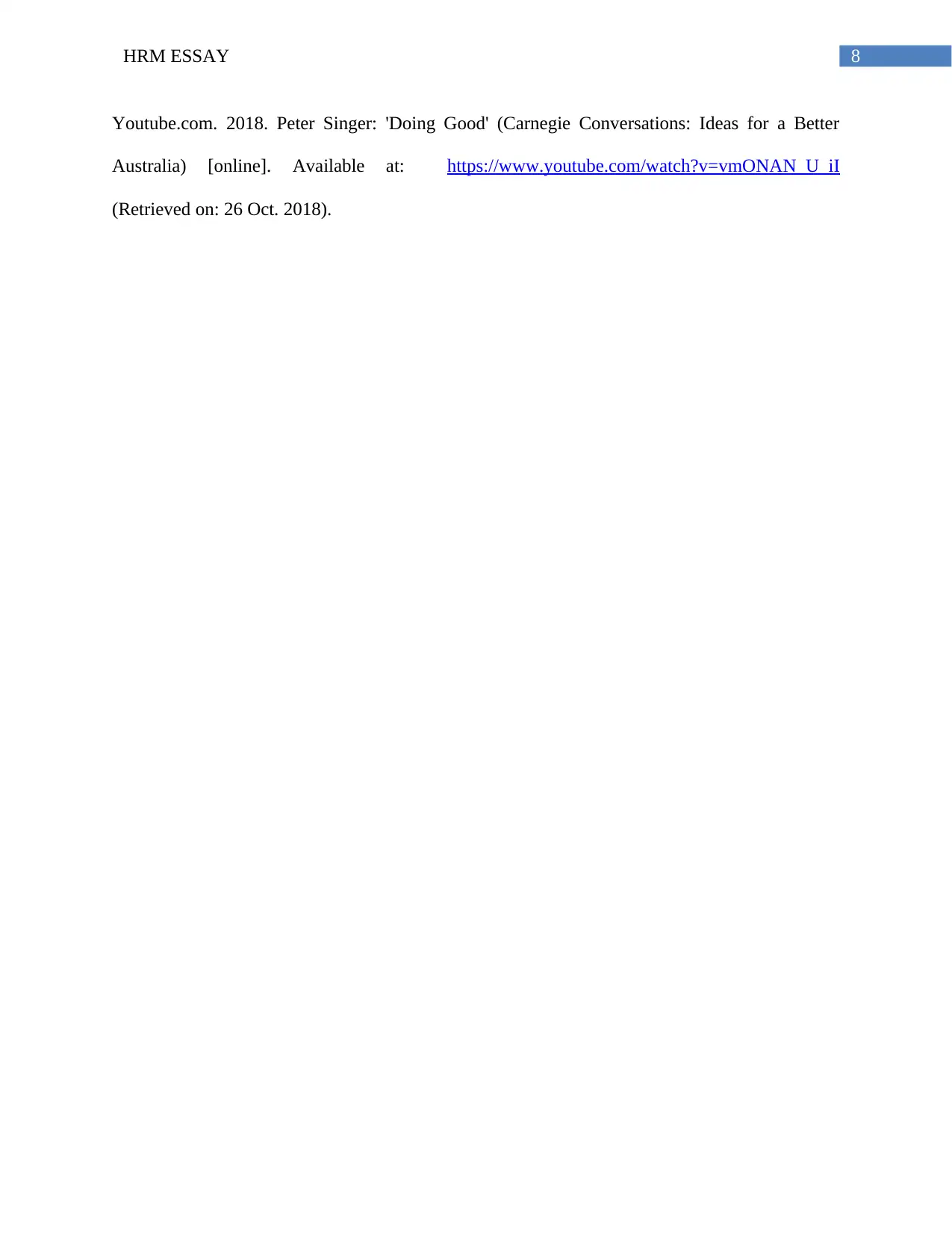
8HRM ESSAY
Youtube.com. 2018. Peter Singer: 'Doing Good' (Carnegie Conversations: Ideas for a Better
Australia) [online]. Available at: https://www.youtube.com/watch?v=vmONAN_U_iI
(Retrieved on: 26 Oct. 2018).
Youtube.com. 2018. Peter Singer: 'Doing Good' (Carnegie Conversations: Ideas for a Better
Australia) [online]. Available at: https://www.youtube.com/watch?v=vmONAN_U_iI
(Retrieved on: 26 Oct. 2018).
⊘ This is a preview!⊘
Do you want full access?
Subscribe today to unlock all pages.

Trusted by 1+ million students worldwide
1 out of 9
Related Documents
Your All-in-One AI-Powered Toolkit for Academic Success.
+13062052269
info@desklib.com
Available 24*7 on WhatsApp / Email
![[object Object]](/_next/static/media/star-bottom.7253800d.svg)
Unlock your academic potential
Copyright © 2020–2025 A2Z Services. All Rights Reserved. Developed and managed by ZUCOL.





